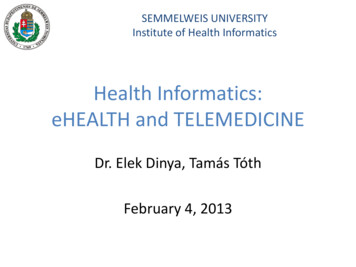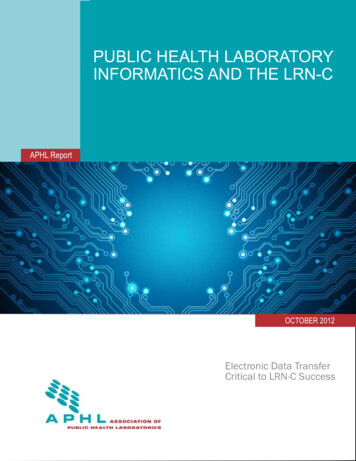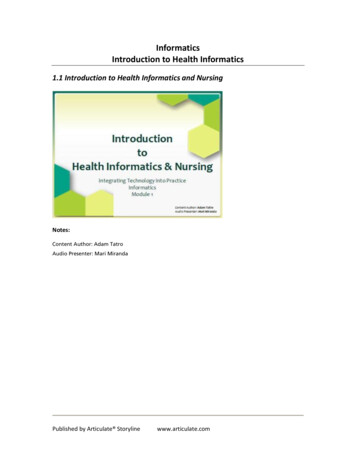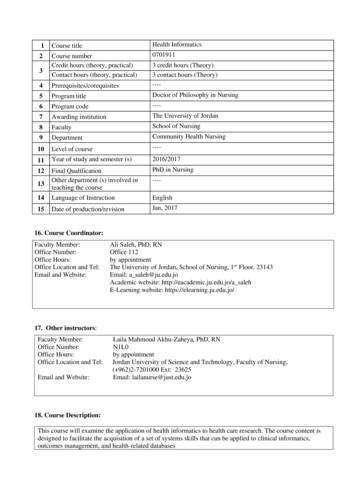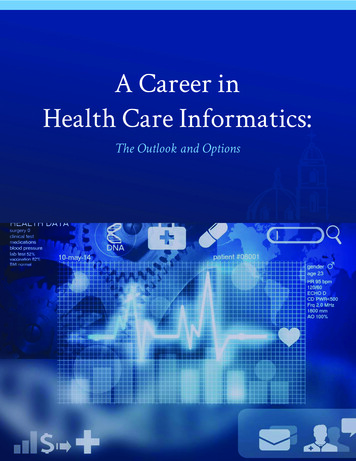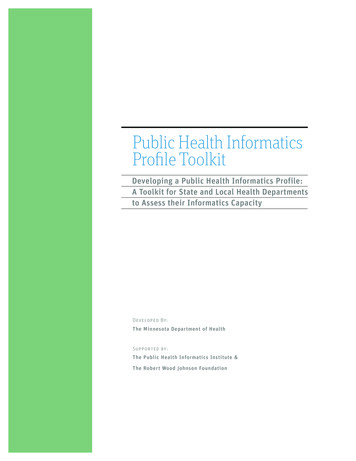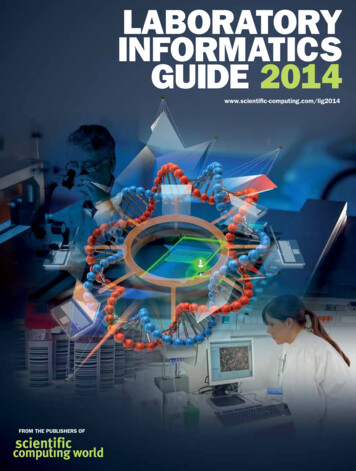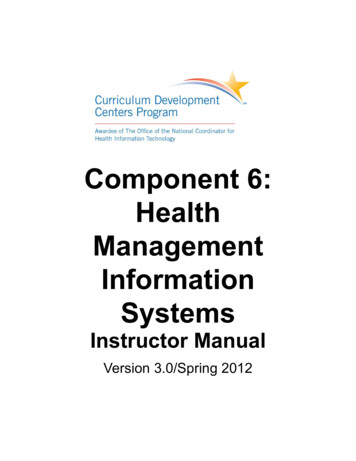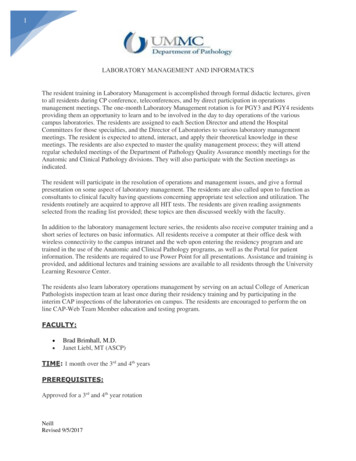
Transcription
1LABORATORY MANAGEMENT AND INFORMATICSThe resident training in Laboratory Management is accomplished through formal didactic lectures, givento all residents during CP conference, teleconferences, and by direct participation in operationsmanagement meetings. The one-month Laboratory Management rotation is for PGY3 and PGY4 residentsproviding them an opportunity to learn and to be involved in the day to day operations of the variouscampus laboratories. The residents are assigned to each Section Director and attend the HospitalCommittees for those specialties, and the Director of Laboratories to various laboratory managementmeetings. The resident is expected to attend, interact, and apply their theoretical knowledge in thesemeetings. The residents are also expected to master the quality management process; they will attendregular scheduled meetings of the Department of Pathology Quality Assurance monthly meetings for theAnatomic and Clinical Pathology divisions. They will also participate with the Section meetings asindicated.The resident will participate in the resolution of operations and management issues, and give a formalpresentation on some aspect of laboratory management. The residents are also called upon to function asconsultants to clinical faculty having questions concerning appropriate test selection and utilization. Theresidents routinely are acquired to approve all HIT tests. The residents are given reading assignmentsselected from the reading list provided; these topics are then discussed weekly with the faculty.In addition to the laboratory management lecture series, the residents also receive computer training and ashort series of lectures on basic informatics. All residents receive a computer at their office desk withwireless connectivity to the campus intranet and the web upon entering the residency program and aretrained in the use of the Anatomic and Clinical Pathology programs, as well as the Portal for patientinformation. The residents are required to use Power Point for all presentations. Assistance and training isprovided, and additional lectures and training sessions are available to all residents through the UniversityLearning Resource Center.The residents also learn laboratory operations management by serving on an actual College of AmericanPathologists inspection team at least once during their residency training and by participating in theinterim CAP inspections of the laboratories on campus. The residents are encouraged to perform the online CAP-Web Team Member education and testing program.FACULTY: Brad Brimhall, M.D.Janet Liebl, MT (ASCP)TIME: 1 month over the 3rd and 4th yearsPREREQUISITES:Approved for a 3rd and 4th year rotationNeillRevised 9/5/2017
2OBJECTIVES OF THE TRAINING ROTATIONI. Patient Care: Procedural SkillsA. Objectives:1. Understand the day-to-day operations of the various campus laboratories2. Understand and master the quality management process in the individual laboratories3. Understand the day-to-day management issues and challenges of the various campuslaboratories4. Understand resolution of operations and management issuesB. Plan:1. Teaching Method: Daily observation of the various laboratory management conferencesand medical director’s conferences during the section rotation or when a departmentalmeeting.C. Supervision / Assessment:1. Methods of Assessmenta. Weekly meetings with Director of Clinical Pathologyb. End-of-Rotation Evaluation2. Assessor(s)a. Faculty, Laboratory staffb. Medical DirectorsII. Medical KnowledgeA. Objectives:1. Understand principles of practice management theoryB. Plan:1. Reading Requirements: Selected articles in multiple journals and selected chapters frommanagement textbooks2. Required attendance:3. Clinical Pathology (CP) Conference, Anatomic Pathology Conferences Anatomic Pathand Clinical Pathology and Combined Performance Improvement Conferences. Weekly meetings with CP Director Informatics3. Clinical Medical Laboratories Director Meeting During Section Rotations:a. Individual Meeting With Anatomic Pathology Medical Laboratory Directorb. Individual Meeting with Transfusion Medicine Medical Directorc. Individual Meeting with Microbiology Medical Directord. Individual Meeting with Hematology Medical Laboratory Directore. Individual Meeting with Coagulation-PeriNatal Medical Laboratory Directorf. Individual Meeting with Clinical Chemistry Medical Director4. Lab Management Meetings During Section Rotationa. Immunology Managementb. Lab Central Managementc. Clinical Chemistry Lab Managementd. Hematology ManagementNeillRevised 9/5/2017
3e. Coagulation-PeriNatal Managementf. Blood Bank Managementg. Microbiology Management5. Quality Assessment Management Meetings:a. Monthly Anatomic PI meetingb. Monthly Clinical Laboratory PI meetingsc. Combined Monthly AP CP PI meetingD. Supervision / Assessment:4. Supervision:a. Faculty5. Assessment:a. Weekly meetings with Director of Clinical Pathologyb. End-of-Rotation EvaluationIII. Practice-Based Learning and ImprovementA. Objectives1. Understand the practical aspects of laboratory management in different situations2. Successful completion of College of American Pathology (CAP) InspectionB. Plan1. Interact with laboratory managers and directors in private, State and County based systems2. Participate in external CAP Inspection3. Participate in internal CAP Inspection4. Complete CAP Web-based training for inspectorsC. Supervision / Assessment1. Supervisiona. Faculty2. Assessor(s)a. Weekly meetings with Director of Clinical Pathologyb. End-of-Rotation EvaluationIV. Interpersonal and Communication SkillsA. Objectives1. Effective interaction with internal and external laboratory management staff2. Effective verbal communication with internal and external laboratory managementB. Plan1. Methoda. Daily interaction with senior management and physicians at weekly conferencesb. Required attendance at weekly meetings2. Required Presentationsa. Required attendance at meetingsNeillRevised 9/5/2017
4b. Required attendance and presentation at Clinical Pathology Rounds case studyand presentationsC. Supervision / Assessment:1. Feedback from internal and external laboratory faculty and staffV. ProfessionalismA. Objectives:1. Ethical and morally acceptable behavior2. Leading by example3. Following the “Golden Rule”4. Dressing for success (neatness counts!)B. Plan:1. Method of Learning: By example provided by the facultyC. Supervision / Assessment:1. Methods of Assessment: Observation and counseling, when needed, on opportunities forimprovement2. Assessor(s): FacultyCONFERENCESD. Clinical Pathology (CP) Director Meetings1. Weekly meetings with CP Director2. Lab Mgmt3. InformaticsE. Clinical Laboratories Director Meetings1. Medical Directors Collective Meetinga. Individual Meeting with Clinical Chemistry Assistant Medical Directorb. Individual Meeting with Transfusion Medicine Medical Directorc. Individual Meeting with Microbiology Medical Directord. Individual Meeting with Clinical Chemistry Medical DirectorF. Department of Pathology-UMC Lab Management Meetings:1. Immunology Management2. Lab Central Management3. Hematology Management4. Coagulation/PeriNatal Lab Management5. Clinical Chemistry Lab Management6. Blood Bank Management7. Microbiology ManagementBASIC READING2. Preparation for CAP audio conferencesNeillRevised 9/5/2017
53. Travers, EM, Clinical Laboratory Management, 19984. McPherson and Pincus, Henry’s: Clinical Diagnosis by Laboratory Methods, 21st ed,2007, Chapter One.5. Smith BR, Wells A, Alexander CB, et al. Curriculum content and evaluation of residentcompetency in clinical pathology (laboratory medicine) : a proposal. Clin Chem.2006;52(6):917-9496. Talbert ML, Ashwood ER, Brownlee NA, et al. Resident Preparation for Practice: AWhite Paper From the College of American Pathologists and Association of PathologyChairs. Arch Pathol Lab Med 33:1139-1147, 2009NeillRevised 9/5/2017
6Laboratory Information Systems and Medical InformaticsObjectives:At the end of this rotation, the pathology resident will:Understand the factors relating to selection, implementation, and management oflaboratory information systems (LIS)Be familiar with the regulatory requirements for LIS validationRecognize issues and requirements related to information securityUnderstand the flow of information to and from the LIS and laboratory instruments,reference laboratories, hospital information systems, chargemaster, etcUnderstand the capabilities of the LIS for data analysis, data mining, report generation,statistics, quality control, financial analysis, test workload, etc.Cite examples of interfaces used by the laboratoryBe knowledgeable of common standard communication protocolsCite advantages of using bar code labelsRecognize the differences of various bar codesCite applications of wireless communication used in the laboratoryCite uses for artificial intelligence within the laboratoryBe familiar with the issues related to imaging including: acquisition, display, analysis,storage, and archivingNeillRevised 9/5/2017
3. Travers, EM, Clinical Laboratory Management, 1998 4. McPherson and Pincus, Henry's: Clinical Diagnosis by Laboratory Methods, 21st ed, 2007, Chapter One. 5. Smith BR, Wells A, Alexander CB, et al. Curriculum content and evaluation of resident competency in clinical pathology (laboratory medicine) : a proposal. Clin Chem. 2006;52(6):917-949 6.
